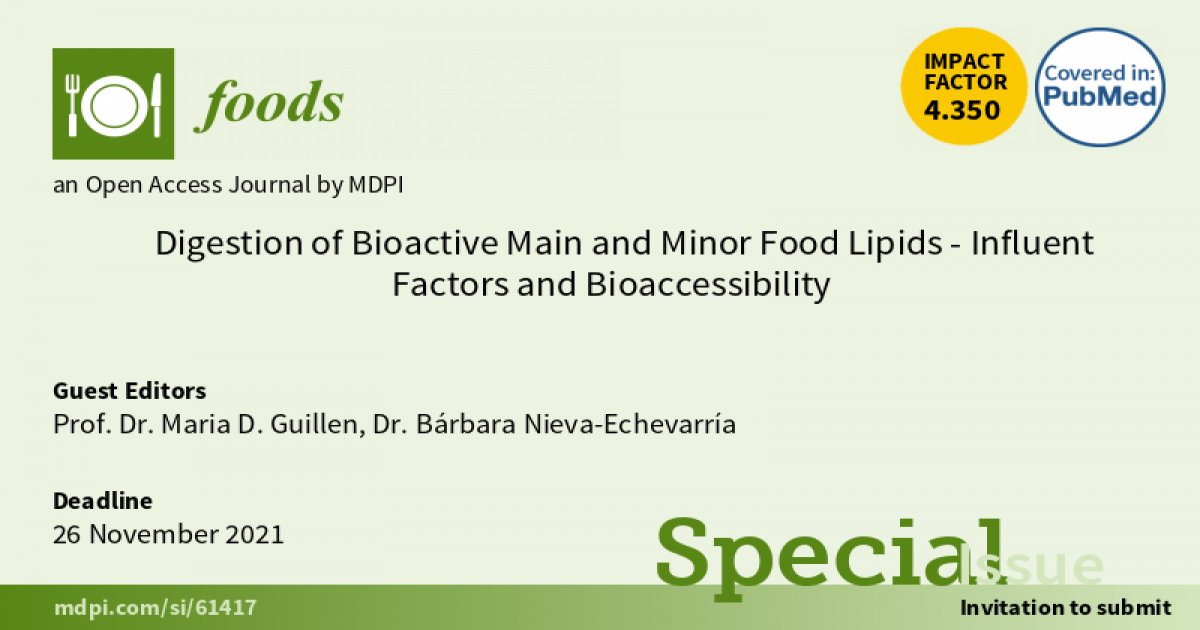Digestion of Bioactive Main and Minor Food Lipids - Influent Factors and Bioaccessibility
A special issue of Foods (ISSN 2304-8158). This special issue belongs to the section "Food Physics and (Bio)Chemistry".
Deadline for manuscript submissions: closed (26 November 2021) | Viewed by 15978

Special Issue Editors
Interests: food lipid characterization; oxidative stability; lipid oxidation; thermo-oxidation; frying; derived oxidation compounds; alpha,beta-unsaturated oxygenated aldehydes and other oxylipins; effect of antioxidant/pro-oxidant compounds; in vitro digestion; bioaccessibility; food processing and storage; food enrichment; smoking; polycyclic aromatic hydrocarbons; volatile and non-volatile food components; gas chromatography/mass spectrometry; Fourier transform infrared spectroscopy; nuclear magnetic resonance; headspace solid-phase microextraction; direct immersion solid-phase microextraction
Interests: lipid oxidation; alpha,beta-unsaturated oxygenated aldehydes; compounds showing antioxidant/pro-oxidant activity; in vitro digestion; bioaccessibility; food lipids; fish; frying oils; thermo-oxidation; oxidative stability; food processing and storage; food enrichment; nuclear magnetic resonance; gas chromatography; Fourier transform infrared spectroscopy
Special Issue Information
Dear Colleagues,
Digestion of food lipid components has become a subject of major interest for scientists from disciplines such as nutrition and food science and technology due to its impact on human health. A great deal of work has therefore been done in recent years to increase the knowledge of both the bioaccessibility of several lipidic compounds and the factors influencing it, in order to increase the potential benefits derived from their absorption. For this purpose, in-depth study of the lipolysis reaction and related phenomena has been necessary. In addition, other chemical reactions such as the oxidation occurring under gastrointestinal conditions may also have a significant impact on lipid digestion and related health effects. Thus, investigations shedding light on the influence of factors such as the unsaturation degree and initial oxidative status of the involved lipids, the presence of other food components showing antioxidant or pro-oxidant activity, and the different digestion models employed on the oxidation extent are of great importance. Likewise, the study of oxylipin formation, including oxygenated aldehydes, as well as their identification and quantification, is of relevance, since this would allow not only evaluating the oxidation extent reached but also analyzing the relationships that are likely to occur between oxidation, lipase activity, lipolysis degree, and Maillard-type reactions. The influence of all the aforementioned factors on the digestibility, bioaccessibility, and bioavailability of major and minor lipid components and oxidation-derived compounds are also issues with nutritional or toxicological repercussions closely related to oxidation processes during digestion. Furthermore, the development of new techniques and the complementarity among the classic and the more advanced ones can contribute to our understanding of the above-mentioned topics.
This Special Issue is focused on studying lipid digestion, oxidation, and related reactions under digestion conditions, as well as the factors influencing their occurrence and the potential impact of food lipid components on health.
Kinds regards,
Prof. Dr. Maria D. Guillen
Dr. Bárbara Nieva-Echevarría
Guest Editors
Manuscript Submission Information
Manuscripts should be submitted online at www.mdpi.com by registering and logging in to this website. Once you are registered, click here to go to the submission form. Manuscripts can be submitted until the deadline. All submissions that pass pre-check are peer-reviewed. Accepted papers will be published continuously in the journal (as soon as accepted) and will be listed together on the special issue website. Research articles, review articles as well as short communications are invited. For planned papers, a title and short abstract (about 100 words) can be sent to the Editorial Office for announcement on this website.
Submitted manuscripts should not have been published previously, nor be under consideration for publication elsewhere (except conference proceedings papers). All manuscripts are thoroughly refereed through a single-blind peer-review process. A guide for authors and other relevant information for submission of manuscripts is available on the Instructions for Authors page. Foods is an international peer-reviewed open access semimonthly journal published by MDPI.
Please visit the Instructions for Authors page before submitting a manuscript. The Article Processing Charge (APC) for publication in this open access journal is 2900 CHF (Swiss Francs). Submitted papers should be well formatted and use good English. Authors may use MDPI's English editing service prior to publication or during author revisions.
Keywords
- gastrointestinal digestion
- lipid oxidation
- bioactive compounds
- antioxidants/pro-oxidants
- lipolysis extent
- digestibility
- lipase activity
- bioaccessibility
- toxic oxidation products
- nutritional implications
- cytotoxic studies
- advanced and classic techniques
Benefits of Publishing in a Special Issue
- Ease of navigation: Grouping papers by topic helps scholars navigate broad scope journals more efficiently.
- Greater discoverability: Special Issues support the reach and impact of scientific research. Articles in Special Issues are more discoverable and cited more frequently.
- Expansion of research network: Special Issues facilitate connections among authors, fostering scientific collaborations.
- External promotion: Articles in Special Issues are often promoted through the journal's social media, increasing their visibility.
- Reprint: MDPI Books provides the opportunity to republish successful Special Issues in book format, both online and in print.
Further information on MDPI's Special Issue policies can be found here.







